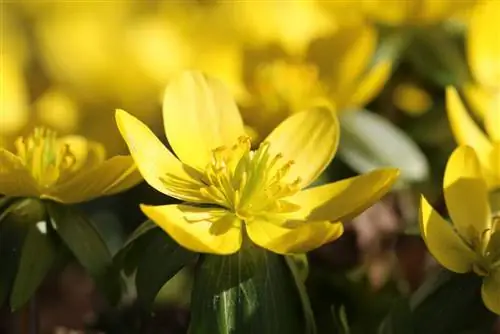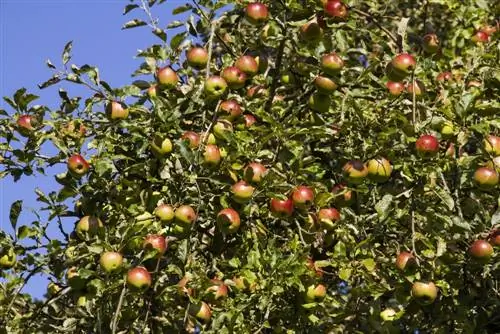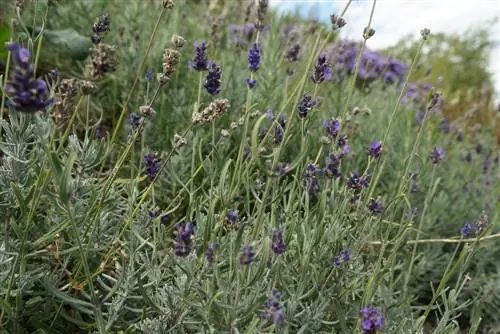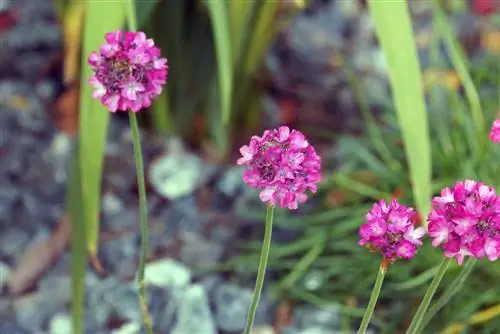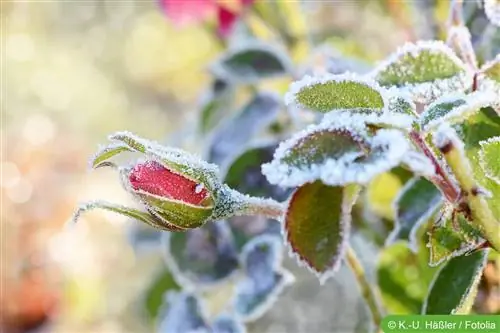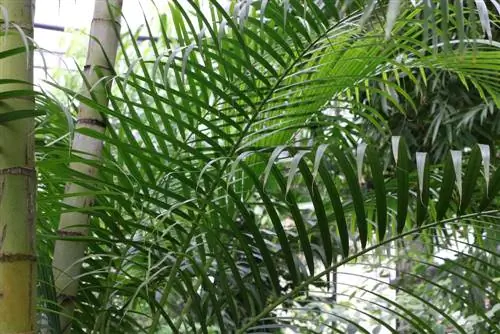- Author admin [email protected].
- Public 2023-12-17 03:39.
- Last modified 2025-01-24 12:45.
Fragrant winter aconites resemble golden yellow buttercups in mini format, equipped with a green ruff. Already in late winter they bravely defy frost and snow to herald the approach of spring. If the pretty flowers break through the thin blanket of snow, the gardener has done everything right in advance. In order for Eranthis hyemalis to thrive in the bed, skillful planting and careful care are important. The following instructions explain in practical terms how to cultivate winter aconites in an exemplary manner.
Plants
Winter aconites take one to two years until they begin to develop the desired flower carpets. If the small yellow flowers initially only appear sporadically over a green ruff, this shortcoming does not necessarily mean that there have been omissions in planting and care. Extensive populations of wild animals always indicate an established garden. The same applies to the cultivated winter aconites that immigrated from southeastern Europe. If you follow these instructions, all that is required is a little patience until Eranthis hyemalis develops its full potential.
Planting time and seedlings
Unlike other early bloomers, winter aconites do not sprout from bulbs, but from tuberous rhizomes. These come into the ground in as fresh and moist a condition as possible. If the tubers are dried out and shriveled, the chances of them developing into a vital Eranthis hyemalis are slim. The months of September and October are considered the ideal planting time. Alternatively, purchase early spring young plants to use in January or February.
Location
The choice of the appropriate location determines the successful cultivation of winter aconites in the bed. Assign the tubers or young plants a location with these conditions:
- Partly shaded, bright spring location
- Ideally in the protection of late-blooming deciduous trees
- Fresh, moist, nutrient-rich soil, rich in humus
- Light to medium lime content is an advantage
In the immediate vicinity of coniferous trees or ericaceous plants, such as rhododendrons, the soil is too acidic for winter aconites. In addition, avoid placing it in dry, sandy soil, such as that which dominates the gravel bed or rock garden. The mini flowers only require light and sun during the growing season. After they have removed all the flowers and leaves in June, the location can easily be in the deepest shade.
Tip:
Winterlings are highly poisonous in all parts. Wearing gloves is therefore mandatory for all work related to plants and care.
Plants
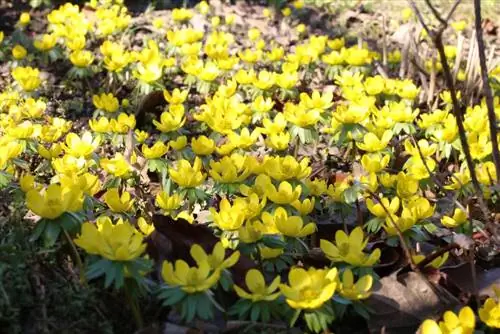
Experienced hobby gardeners start planting winter aconites as soon as they have the freshest possible planting material in their hands. It is an advantage if the tubers can soak in water a few hours beforehand. This time can be used to prepare the soil at the chosen location. Thorough weeding is just as important as carefully removing roots and stones. How to plant winter aconites with expertise:
- Dig small planting holes 5 cm apart
- Enrich the excavation with compost or leaf mold
- Optimize heavy clay soil with sand
- Plant one tuber at a time 5-7 cm deep
- After watering, cover with a little peat moss
If possible, you should not chop in a bed with winter aconites, as this will damage the sensitive roots. Therefore, mark the planting site so that you can simply pull out any weeds that appear here.
Protection from voles
Since voles like to eat the tubers of winter aconites, planting with a vole basket is recommended. The close-meshed wire meshes are available from specialist retailers or can be constructed yourself with a little craftsmanship. In this case, the planting holes are dug a little deeper at 15 centimeters. After you have placed the vole basket in the pit, first add a 2 centimeter high layer of sand to fill in the excavated material and plant the tubers in the manner described. You can do without a wire mesh as a lid because the pests cannot penetrate to the surface.
Care
The focus of exemplary care is regular water supply, because winter aconites cannot accept dryness. The administration of fertilizer is viewed critically by most gardeners. It is feared that additional nutrients will only cause increased foliage growth at the expense of vital flowers. In addition, in this case compost cannot be used for natural fertilization, as a rake should not be used near winter aconites. It is therefore hardly possible to incorporate the material.
Pruning Eranthis hyemalis is unnecessary because the buttercup plants grow their above-ground plant parts independently. Avoid prematurely cleaning out wilted flowers and leaves. As these yellow, they release valuable nutrients into the underground rhizome. From this, a winter aconite creates reserves to bloom again next year.
Winter protection in the planting year
If the tubers of winter aconites are planted in autumn, it is advisable to provide light protection from frost and snow for the first winter in rough locations. To do this, cover the planting site with leaves, straw or pine branches. Alternatively, garden fleece or jute can serve as a protective cover. It is important to note that winter protection must be removed in good time when temperatures rise above zero degrees. Otherwise, condensation could form, leading to the formation of mold.
Propagate
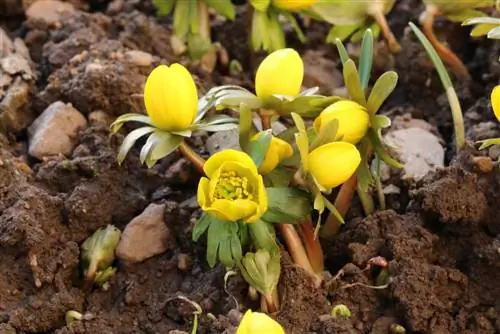
Winter aconites take 10 years or more to develop dense carpets of flowers as part of the naturalization process. If that takes too long for you, give the early bloomers a helping hand with targeted propagation. Hobby gardeners have the choice between the following two methods:
Division
This approach can be considered if the winter aconites have already conquered a larger bed area. How to do it right:
- After flowering, cut out individual specimens including the root ball
- Cut the root ball into several pieces about the size of a fist
- Dig planting holes 20 to 30 centimeters apart
- Plant the rhizome pieces in it and water it
During this procedure, leave the leaves on the winter aconites so that the residual nutrients they contain can be assimilated into the tuber by June.
Sowing
When the flowering comes to an end in March, small follicles form in a star-shaped arrangement instead of the flowers. In the period from late March to early May, these fruits release several easily recognizable seeds. You can harvest and sow these. A little sense of proportion is required here. Anyone who waits too long to harvest will lose out because the seeds will be thrown out when rain hits the ripe fruit. This is how sowing works:
- At the recommended location, till the soil until it is finely crumbly
- Spread the freshly harvested seeds
- Work the light germs in just a little with the rake
- Water the seedbed with a fine spray
A close-meshed net or garden fleece is used to protect against pecking birds or voracious pests.
Sociable neighborhood
In association with snowdrops, winter aconites spread a magical, spring-like flair in the garden. The two fragrant plants compete for the first flower of the year. Eranthis hyemalis also maintains the best neighborhood with the following early bloomers:
- Spring Anemone (Anemone blanda)
- Crocus (Crocus)
- Bush anemone (Anemone nemorosa)
- Snow shine (Chionodoxa forbesii)
- Fingered Larkspur (Corydalis solida 'GP Baker')
- Snow Crocus (Crocus chrysanthus)
- Dog Tooth (Erythronium dens-canis)
- Checkerboard flower (Fritillaria meleagris)
However, it is not recommended to be in close proximity to magnificent perennials, as the presence of winter aconites makes care work very difficult. In contrast, Eranthis hyemalis know how to hold their own among tall ferns and create an eye-catching green-yellow color contrast during flowering.
Conclusion
Indispensable guests in early spring are the golden-yellow flowering winter aconites. If you give the small scented flowers enough time, a magnificent carpet of flowers will develop under tall deciduous trees or along protected embankments. In order for the planting to be successful, the tubers should be planted in the soil as freshly as possible. Both autumn and late winter are suitable planting times. In endangered locations, protection against voles is recommended. As long as care is limited to regular watering and the bed is not hoeed, the busy Eranthis hyemalis will present themselves anew every year. In order to accelerate the spread, uncomplicated propagation methods can be considered, such as division or sowing self-harvested seeds. In all work related to planting and caring for winter aconites, the toxic content must not be underestimated.

